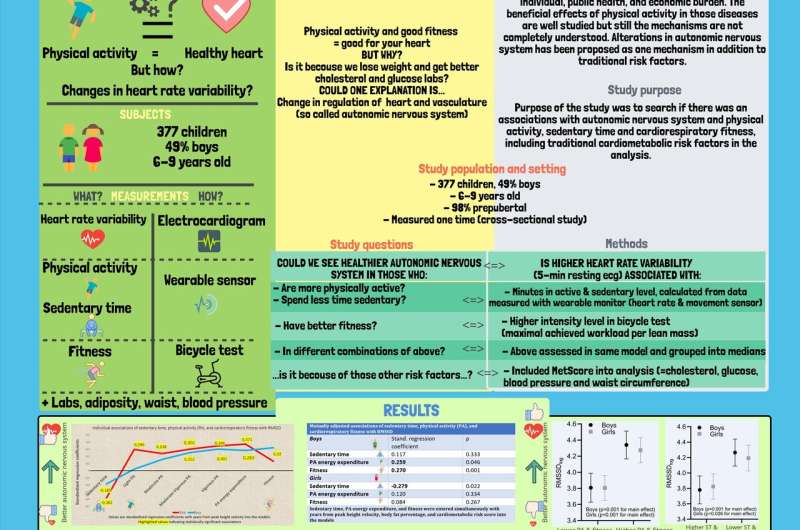Credit: University of Eastern Finland (UEF Viestintä)
A recent Finnish study showed that more physically active and fit children have better cardiac regulation than less active and fit children. The study also showed that cardiac regulation was better especially in boys with better aerobic fitness and in girls with lower levels of sedentary time. The results, based on the Physical Activity and Nutrition (PANIC) Study conducted at the University of Eastern Finland, were published in the European Journal of Applied Physiology.
Cardiovascular diseases cause a remarkable individual, public health, and economic burden globally. Cardiovascular diseases have their origins in childhood, and physical activity has been found to prevent or postpone the development of these diseases. However, the mechanisms for the beneficial effects of physical activity are not completely understood. Improvements in cardiac regulation by the autonomic nervous system in response to physical activity have been proposed as one of these mechanisms. Nevertheless, there are few studies linking physical activity and aerobic fitness with cardiac autonomic regulation in children.
Altogether 377 children aged six to nine years participated in the study. Cardiac autonomic regulation was assessed by heart rate variability from electrocardiograms, physical activity and sedentary time by a combined heart rate and movement sensor, and aerobic fitness by a maximal exercise test on a bicycle ergometer. The data were adjusted for maturation, body fat percentage, waist circumference, fasting plasma glucose, plasma lipids, and blood pressure.
The researchers found that higher sedentary time and lower levels of physical activity and aerobic fitness were associated with poorer cardiac autonomic nervous system function in children. They also observed that particularly high levels of vigorous physical activity had a strong relationship to better cardiac autonomic nervous system function. Lower aerobic fitness in boys and higher sedentary time in girls were the strongest correlates of poorer cardiac autonomic nervous system function. These associations were independent of other cardiometabolic risk factors.
"Our study provides novel and valuable information as we were able to study the role of not only physical activity but also sedentary time, aerobic fitness, and other cardiometabolic risk factors as correlates of cardiac autonomic nervous system function in children," says Dr. Aapo Veijalainen, MD, Ph.D., from University of Eastern Finland.
We can conclude that the beneficial effects of a physically active lifestyle and good aerobic fitness go beyond traditional cardiovascular risk factors and all measures that get children to move must be supported.
More information: Aapo Veijalainen et al. Associations of physical activity, sedentary time, and cardiorespiratory fitness with heart rate variability in 6- to 9-year-old children: the PANIC study, European Journal of Applied Physiology (2019). DOI: 10.1007/s00421-019-04231-5
Journal information: European Journal of Applied Physiology
Provided by University of Eastern Finland























